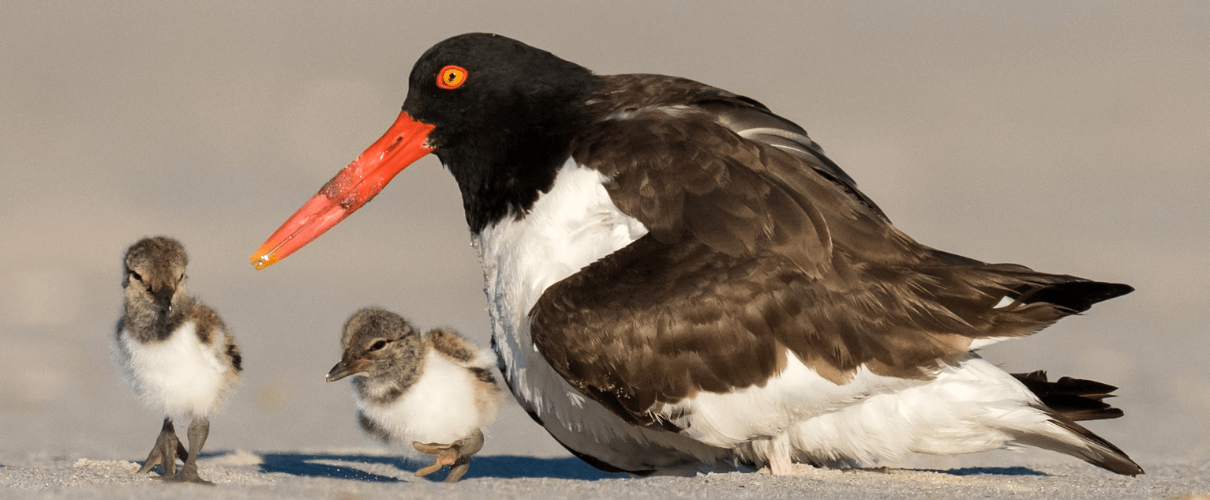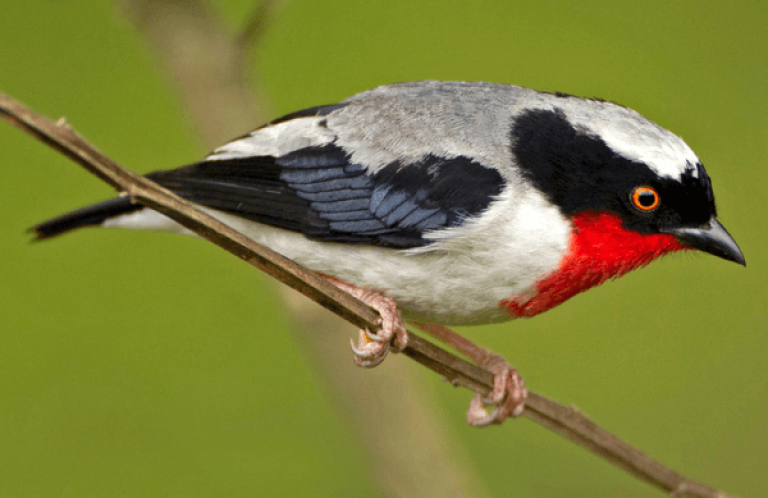Tips to Safely Share the Beach with Shorebirds this 4th of July

American Oystercatcher and chicks by Harry Collins Photography/Shutterstock
(June 29, 2022) This 4th of July, millions of people and birds alike will be sharing U.S. beaches. Humans flock to the shore to celebrate the holiday with fireworks and barbecues, while birds like American Oystercatcher, Black Skimmer, Least Tern, Snowy Plovers, and Wilson's Plovers gather to forage and raise their young. With so many individuals of various kinds wanting their own place on the beach, things can get crowded.
The competition for space with people can stress out nesting birds, but there are ways to safely share the beach. Avoid disrupting our fellow feathered beachgoers by adhering to the following tips from American Bird Conservancy (ABC).
Tips to Share the Beach and Help Coastal Birds
- Celebrate responsibly. During the Fourth of July, fireworks put extra stress on shorebirds. The loud noise can startle them, leading to collisions with nearby buildings. “If fireworks are a must, choose quieter options and enjoy them away from habitat where wildlife might be roosting and nesting,” said Richard Gibbons, Gulf Coastal Program Manager at ABC.
- Pick up trash, and pack it out. Birds can be killed by plastic pollution when they accidentally ingest it or become tangled in it, and that includes firework trash. Fireworks shoot off small pieces of plastic into the environment that can be harmful to birdlife, so remember to clean up after your celebration. While many beaches have trash cans, these can overflow on busy holiday weekends; the best way to ensure your trash doesn't wind up on the beach or in the water is to pack out what you pack in. As much as possible, stick to reusable plates, utensils, and containers to cut down on plastic waste.
- Don't feed gulls. Gulls like the Ring-billed and Laughing Gull are observant opportunists, and feeding them will soon draw in even more of these seaside scavengers. That's bad news for shorebirds, because gulls are after more than just your french fries — they will also eat eggs and vulnerable chicks on the ground when given the chance. Human food is also a choking hazard and lower in nutrients than gulls' natural diet; eating it can make them more susceptible to disease.
- Watch where you step. Beach-nesting birds lay their eggs directly on the sand, and those eggs are camouflaged to blend in with their surroundings to keep them safe from predators. However, this defense also makes eggs vulnerable to trampling by humans or off-leash pets. ABC recommends that beachgoers “fish, swim, and play 50 yards away” from any large congregations of birds. When in doubt, stay close to the water — most nesting birds tend to use higher parts of the beach, away from the surf.
- Watch where you drive. What applies to foot traffic also applies to vehicles. If driving on the beach, choose the “path of least disturbance,” Gibbons said. Drive where other vehicles have driven and avoid blazing new trails. If birds are resting on the beach, drive slowly and try to choose a path that doesn't spook them.
- Pay attention to signs. Visitors should respect areas that are roped off or marked with signs indicating that beach-nesting birds are in the vicinity.
- Teach children to play responsibly and avoid nesting areas. Encourage kids to learn about, and watch out for, birds. Ask them to play a safe distance away from nesting birds to avoid disturbing bird families. A good way to spot areas to avoid is to look out for “nesting area” signs posted along the beach, or areas with temporary fencing.
- Keep your dogs on leashes — or at home. Free-roaming dogs mimic natural predators in the eyes of a bird, causing stress and even direct harm to nests, chicks, and adult birds. Dogs can also overheat and/or become dehydrated at the beach, so for their safety as well as that of the birds, consider keeping them at home.
- Know the cues. Beachgoers often can't tell the difference between a bird that is simply sitting on the sand and one that is tending eggs, a nest, or chicks. But certain signals and behaviors indicate the presence of nesting birds. Nesting birds will often call loudly, dive-bomb perceived intruders, or feign injury to lead you away from the nest. If you see any of these behaviors, move away from the birds until they no longer seem agitated.
- Stay close to the water. Most nesting birds tend to use higher parts of the beach, away from the surf. It should be possible to avoid conflict with beach nesters so long as people remain close to the water and away from the dunes or areas behind dunes.
“Taking these actions will do far more than allow these beach-nesting birds to survive,” Gibbons said. “They will profoundly improve your beach-going experience with an increased awareness of place and appreciation of nature.”
Different regions have different species nesting on the beaches, but many have similar behaviors and reactions to being disturbed. Knowing what you might encounter will help you avoid harming the birds, and it can make your beach trip even more fun. Here are some notable beach-nesting birds in four regions of the United States:
Birds of the Gulf Coast
Least Terns and Black Skimmers nest in colonies along the Gulf Coast. Wilson's and Snowy Plovers maintain single-pair territories, but can often be found within Least Tern colonies. American Oystercatchers tend to be more spread out and favor both beach habitat and islands covered with oyster shells (especially along the upper coast of Texas). Read more about ABC's Gulf Coast conservation effort and how we and our partners are working to help beach-nesting birds.
Birds of the Atlantic Coast
Federally Threatened Piping Plovers can be found on Atlantic Coast beaches extending from North Carolina to Maine. They are especially concentrated along the northeastern coast, notably along the beaches of Long Island, New York, and the southern Delmarva Peninsula. Other species you might encounter include the Least Tern, Black Skimmer, American Oystercatcher, and Wilson's Plover.
Birds of the Pacific Coast
Western beaches host populations of the federally Threatened Western Snowy Plover, Endangered California Least Tern, and the Black Oystercatcher (which is more frequently found on rocky rather than sandy beaches). While the terns tend to be colonial in their nesting habits, the plovers are more spread out, often favoring sites where rivers enter the ocean.
Birds of the Great Lakes
Inland beaches are also crucial habitats for shorebirds, and the Great Lakes area shouldn't be overlooked. Federally Endangered Great Lakes Piping Plovers are making a comeback and expanding their range to include historic nesting areas, including places like Illinois and Ohio. Other shorebird species, such as Killdeer, also rely on these areas.
###
American Bird Conservancy is a nonprofit organization dedicated to conserving wild birds and their habitats throughout the Americas. With an emphasis on achieving results and working in partnership, we take on the greatest problems facing birds today, innovating and building on rapid advancements in science to halt extinctions, protect habitats, eliminate threats, and build capacity for bird conservation. Find us on abcbirds.org, Facebook, Instagram, and Twitter (@ABCbirds).
Media Contact: Jordan Rutter, Director of Public Relations| jerutter@abcbirds.org | @JERutter


















































